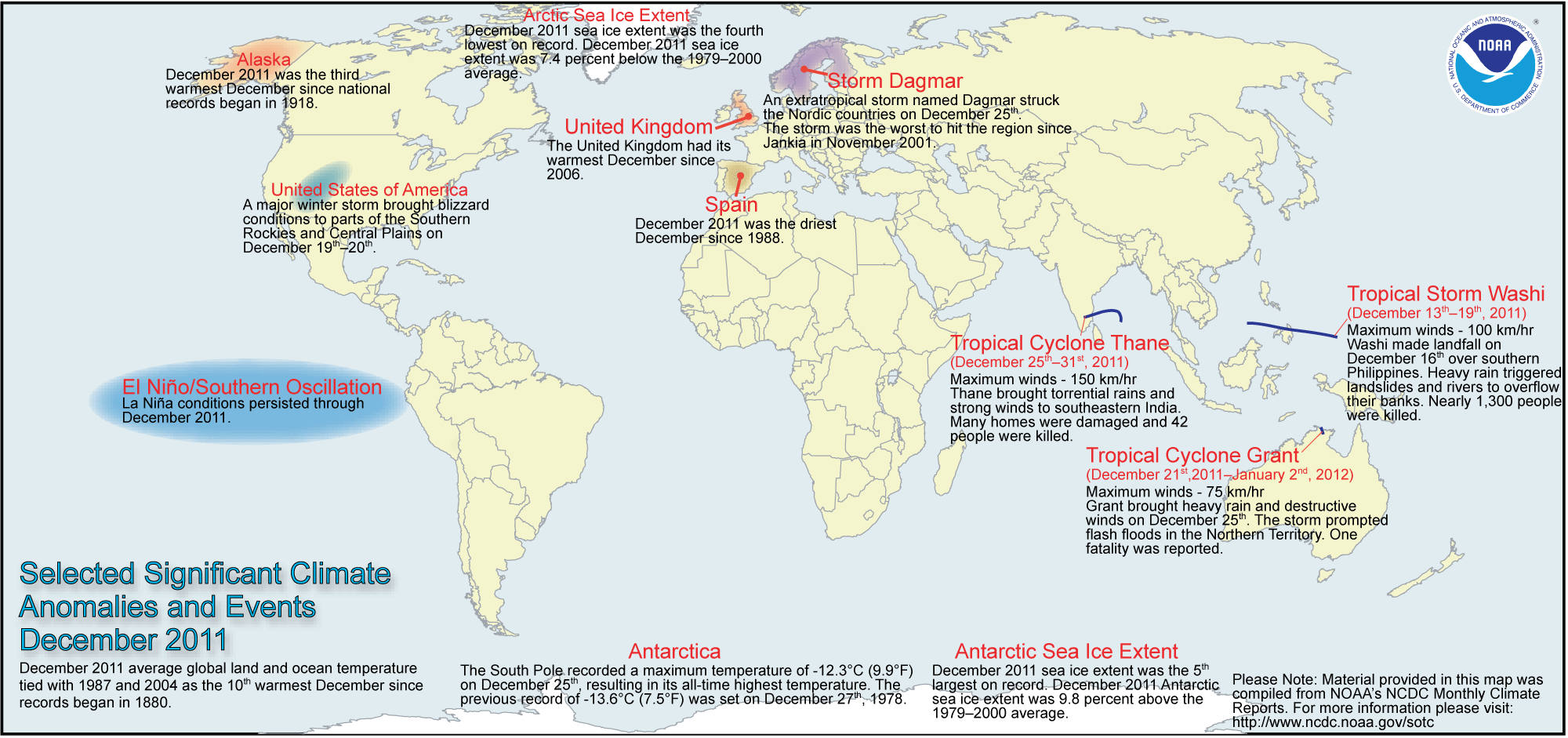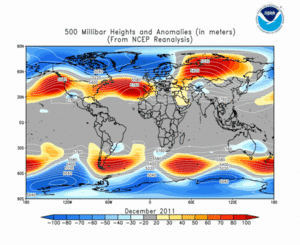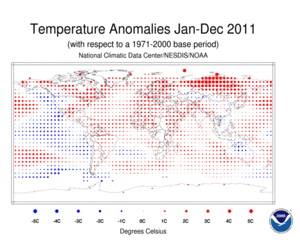Contents of this Section:
 December 2011 Selected Climate
December 2011 Selected Climate
Anomalies and Events Map
Global Highlights
- The combined global land and ocean average surface temperature for December 2011 was 0.48°C (0.86°F) above the 20th century average of 12.2°C (54.0°F). This tied with 1987 and 2004 as the 10th warmest December on record.
- The global land surface temperature for December 2011 was 0.88°C (1.58°F) above the 20th century average of 3.7°C (38.7°F). This tied with 1979 as the eighth warmest December on record.
- The worldwide ocean surface temperature for December 2011 tied with 1972 as the 16th warmest December on record, 0.32°C (0.58°F) above the 20th century average of 15.7°C (60.4°F).
- For the year (January–December), the combined global land and ocean surface temperature tied with 1997 as the 11 th warmest such period on record, at 0.51°C (0.92°F) above the 20th century average of 13.9°C (57.0°F). 2005 and 2010 are tied for warmest year on record, at 0.64°C (1.15°F) above the 20th century average.
Introduction
The data presented in this report are preliminary. Ranks and anomalies may change as more complete data are received and processed. Effective with the July 2009 State of the Climate Report, NCDC transitioned to the new version (version 3b) of the extended reconstructed sea surface temperature (ERSST) dataset. ERSST.v3b is an improved extended SST reconstruction over version 2. For more information about the differences between ERSST.v3b and ERSST.v2 and to access the most current data, please visit NCDC's Global Surface Temperature Anomalies page.
Temperature anomalies for December 2011 and January–December are shown on the dot maps in the following section. The dot maps on the left provide a spatial representation of anomalies calculated from the Global Historical Climatology Network (GHCN) version 3.1.0 dataset of land surface stations using a 1961–1990 base period. The dot maps on the right are a product of a merged land surface and sea surface temperature (SST) anomaly analysis developed by Smith et al. (2008). For the merged land surface and SST analysis, temperature anomalies with respect to the 1971–2000 average for land and ocean are analyzed separately and then merged to form the global analysis. For more information, please visit NCDC's Global Surface Temperature Anomalies page.
Temperatures
In the atmosphere, 500-millibar height pressure anomalies correlate well with temperatures at the Earth's surface. The average position of the upper-level ridges of high pressure and troughs of low pressure—depicted by positive and negative 500-millibar height anomalies on the  December 2011 map—is generally reflected by areas of positive and negative temperature anomalies at the surface, respectively.
December 2011 map—is generally reflected by areas of positive and negative temperature anomalies at the surface, respectively.
December
The December 2011 globally-averaged temperature across land and ocean surfaces was 0.48°C (0.86°F) above the 20th century average of 12.2°C (54.0°F), making this month the 10th warmest December since records began in 1880. This anomaly is significantly lower than the record December warmth in 2006, which was 0.72°C (1.30°F) above average.
Separately, the worldwide average land surface temperature anomaly was 0.88°C (1.58°F), the eighth warmest on record for the month of December. It was most notably warmer than average across much of the higher latitudes in the Northern Hemisphere, including Canada, Scandinavia, most of northern Russia, and the U.S. state of Alaska, which were more than 5°C above normal in many locations, as indicated by the dot maps above. It was also much warmer than normal across the eastern two-thirds of the United States and nearly all of Europe.
- With records dating back to 1918, Alaska reported its third warmest December. The monthly statewide temperature was 4.8°C (8.7°F) above the 1971–2000 average.
- In Norway, the average December temperature was 3.3°C (5.9°F) above average, making this the 20th warmest December since record keeping began in 1900. While the entire country was above average for the month, the greatest warmth was in the north of the country, where it was the 10th warmest on record for Northern Norway.
- The United Kingdom reported its warmest December since 2006. This December was 0.6°C (1.1°F) above the 1971–2000 average and more than 5°C above the record cold December of 2010.
- Germany was also mild, according to Deutscher Wetterdienst. The December temperature was 2.6°C (4.7°F) above the 1981–2010 national average, making this the fifth warmest December since records began in 1881.
It was colder than average in the western United States, southern Greenland, Iran, Central Asia, Mongolia, northern and southeastern China, and most of Australia.
- Australia's nationally-averaged monthly temperature amounted to the coolest December since 2001, according to the Australian Bureau of Meteorology. Both Queensland and New South Wales saw their coolest December since 1999. For New South Wales, this was also the state's third coolest December on record, at 2.46°C (4.43°F) below the 1971–2000 average.
The El Niño-Southern Oscillation (ENSO) is a periodic fluctuation in sea surface temperature (El Niño) and the air pressure of the overlying atmosphere (Southern Oscillation) across the equatorial Pacific Ocean. A weak-to-moderate cold phase (La Niña) ENSO persisted through December as sea surface temperatures in the central and eastern equatorial Pacific Ocean remained cooler than normal. The December 2011 globally-averaged ocean temperature anomaly of 0.32°C (0.58°F) was the 16th warmest on record for December but was the lowest positive anomaly for any month since March 2008, also a La Niña month. The average Northern Hemisphere ocean temperature anomaly was the coolest since April 2011 while the Southern Hemisphere was the coolest since January 2008. According to NOAA's Climate Prediction Center, La Niña is expected to peak during the December–February period and continue into the Northern Hemisphere spring 2012. In addition to the equatorial Pacific, ocean temperatures were also cooler than average across the northeast Pacific, the north central and south Atlantic Ocean, and parts of the mid-latitude Southern oceans. It was notably warmer than average in the north central Pacific Ocean, the eastern Indian Ocean, and parts of the mid-latitude southern oceans. Images of sea surface temperature conditions are available for all weeks during 2011 from the weekly SST page.
| December | Anomaly | Rank (out of 132 years) | Records | ||||
|---|---|---|---|---|---|---|---|
| °C | °F | Year(s) | °C | °F | |||
| Global | |||||||
| Land | +0.88 ± 0.14 | +1.58 ± 0.25 | Warmest | 8th | 2006 | +1.37 | +2.47 |
| Coolest | 125th | 1929 | -1.21 | -2.18 | |||
| Ties: 1979 | |||||||
| Ocean | +0.32 ± 0.04 | +0.58 ± 0.07 | Warmest | 16th | 1997, 2009 | +0.58 | +1.04 |
| Coolest | 117th | 1909 | -0.53 | -0.95 | |||
| Ties: 1972 | |||||||
| Land and Ocean | +0.48 ± 0.09 | +0.86 ± 0.16 | Warmest | 10th | 2006 | +0.74 | +1.33 |
| Coolest | 123rd | 1916 | -0.56 | -1.01 | |||
| Ties: 1987, 2004 | |||||||
| Northern Hemisphere | |||||||
| Land | +1.05 ± 0.13 | +1.89 ± 0.23 | Warmest | 9th | 1939 | +1.79 | +3.22 |
| Coolest | 124th | 1929 | -1.53 | -2.75 | |||
| Ocean | +0.37 ± 0.05 | +0.67 ± 0.09 | Warmest | 11th | 2009 | +0.60 | +1.08 |
| Coolest | 122nd | 1909 | -0.58 | -1.04 | |||
| Land and Ocean | +0.63 ± 0.11 | +1.13 ± 0.20 | Warmest | 7th | 2006 | +0.98 | +1.76 |
| Coolest | 126th | 1917 | -0.73 | -1.31 | |||
| Southern Hemisphere | |||||||
| Land | +0.42 ± 0.11 | +0.76 ± 0.20 | Warmest | 18th | 1972 | +0.85 | +1.53 |
| Coolest | 115th | 1909 | -0.79 | -1.42 | |||
| Ocean | +0.30 ± 0.04 | +0.54 ± 0.07 | Warmest | 25th | 1997 | +0.62 | +1.12 |
| Coolest | 108th | 1910 | -0.48 | -0.86 | |||
| Land and Ocean | +0.32 ± 0.06 | +0.58 ± 0.11 | Warmest | 25th | 1997 | +0.65 | +1.17 |
| Coolest | 108th | 1909 | -0.51 | -0.92 | |||
| Ties: 1983 | |||||||
| Arctic | |||||||
| Land and Ocean | +2.46 ± 0.52 | +4.43 ± 0.94 | Warmest | 3rd | 2006 | +2.83 | +5.09 |
| Coolest | 130th | 1916 | -2.67 | -4.81 | |||
Year-to-date (January-December)
The  January–December map of temperature anomalies shows that warmer-than-average temperatures occurred across much of the globe during 2011. La Niña events at both the beginning and end of the year influenced global temperatures, dampening them from the record warmth observed during 2010 (which tied with 2005). Overall, the worldwide combined land and ocean surface temperature was 0.51°C (0.92°F) above the 20th century average, ranking as the 11th warmest year on record and the coolest year since 2008. This temperature anomaly is 0.13°C (0.23°F) less than the record warmth of 2010 and 2005. Separately, the 2011 average global land surface temperature ranked as the eighth warmest on record and the ocean surface ranked as the 11th warmest.
January–December map of temperature anomalies shows that warmer-than-average temperatures occurred across much of the globe during 2011. La Niña events at both the beginning and end of the year influenced global temperatures, dampening them from the record warmth observed during 2010 (which tied with 2005). Overall, the worldwide combined land and ocean surface temperature was 0.51°C (0.92°F) above the 20th century average, ranking as the 11th warmest year on record and the coolest year since 2008. This temperature anomaly is 0.13°C (0.23°F) less than the record warmth of 2010 and 2005. Separately, the 2011 average global land surface temperature ranked as the eighth warmest on record and the ocean surface ranked as the 11th warmest.
The greatest above-average annual temperature anomalies occurred across the Northern Hemisphere high latitude land areas, particularly central and northern Russia, Scandinavia, and Canada. Also noteworthy, it was warmer than average across the eastern half of the United States, Mexico, most of Europe and Africa, and the north central Pacific Ocean. Temperatures were below normal across the eastern and central Pacific Ocean, west central North America, and north and central Australia. Please refer to the NCDC State of the Climate Annual Global Analysis report for more detailed information.
| January–December | Anomaly | Rank (out of 132 years) | Records | ||||
|---|---|---|---|---|---|---|---|
| °C | °F | Year(s) | °C | °F | |||
| Global | |||||||
| Land | +0.83 ± 0.18 | +1.49 ± 0.32 | Warmest | 8th | 2007 | +1.05 | +1.89 |
| Coolest | 125th | 1907 | -0.56 | -1.01 | |||
| Ocean | +0.40 ± 0.03 | +0.72 ± 0.05 | Warmest | 11th | 2003 | +0.52 | +0.94 |
| Coolest | 122nd | 1909 | -0.45 | -0.81 | |||
| Ties: 2007 | |||||||
| Land and Ocean | +0.51 ± 0.08 | +0.92 ± 0.14 | Warmest | 11th | 2005, 2010 | +0.64 | +1.15 |
| Coolest | 122nd | 1908, 1909, 1911 | -0.42 | -0.76 | |||
| Ties: 1997 | |||||||
| Northern Hemisphere | |||||||
| Land | +0.94 ± 0.24 | +1.69 ± 0.43 | Warmest | 6th | 2007 | +1.19 | +2.14 |
| Coolest | 127th | 1884 | -0.65 | -1.17 | |||
| Ocean | +0.39 ± 0.04 | +0.70 ± 0.07 | Warmest | 13th | 2005 | +0.54 | +0.97 |
| Coolest | 120th | 1910 | -0.46 | -0.83 | |||
| Land and Ocean | +0.60 ± 0.14 | +1.08 ± 0.25 | Warmest | 10th | 2010 | +0.75 | +1.35 |
| Coolest | 123rd | 1912 | -0.43 | -0.77 | |||
| Ties: 2001 | |||||||
| Southern Hemisphere | |||||||
| Land | +0.52 ± 0.11 | +0.94 ± 0.20 | Warmest | 14th | 2005 | +0.87 | +1.57 |
| Coolest | 119th | 1917 | -0.71 | -1.28 | |||
| Ties: 1991 | |||||||
| Ocean | +0.41 ± 0.03 | +0.74 ± 0.05 | Warmest | 11th | 1998 | +0.54 | +0.97 |
| Coolest | 122nd | 1911 | -0.46 | -0.83 | |||
| Land and Ocean | +0.43 ± 0.06 | +0.77 ± 0.11 | Warmest | 12th | 1998 | +0.58 | +1.04 |
| Coolest | 121st | 1911 | -0.47 | -0.85 | |||
| Arctic | |||||||
| Land and Ocean | +1.53 ± 0.14 | +2.75 ± 0.25 | Warmest | 1st | 2007 | +1.50 | +2.70 |
| Coolest | 132nd | 1902 | -1.26 | -2.27 | |||
The most current data may be accessed via the Global Surface Temperature Anomalies page.
Precipitation
The maps below represent anomaly values based on the GHCN version 2 dataset of land surface stations using a base period of 1961–1990. During December 2011, above-average precipitation fell over areas that included much of Australia, Alaska, the south central United States, northern Mexico, Central America, northwestern South America, and Western and Northern Europe. Drier-than-average conditions were present across the northern and far western United States, southern South America, Southern Europe, much of South and East Asia, and parts of North and West Africa.
- Following the driest month ever recorded in Germany, December 2011 was much wetter than normal, at 69.1 percent above the 1981–2010 average, and ranks as the fifth wettest December in the country's 131-year period of record. Several large storms throughout the month contributed to the wetness, according to Germany's National Meteorological Service, DWD.
- It was also wet in Norway. This month tied with December 1991 as the seventh wettest such period on record, at 30 percent above average, as reported by the Meteoroloisk Institutt. Several stations on the west coast recorded their wettest December on record.
- Conversely, it was Spain's driest December since 1988 and fourth driest in the past half century, according to the country's national meteorological agency, AEMET. On average, Spain received 25 mm of rainfall, which is less than one-third of normal for the month.
- La Niña conditions contributed to heavier-than-average rainfall over Australia in December. The country had its 25th wettest December since records began in 1900, with rainfall 34 percent above normal. With the exception of Tasmania, which experienced its driest December since 1994, all states reported above-average precipitation.
- In New Zealand, precipitation varied across the country. According to NIWA, most of the North Island and northern South Island received more than two times the average monthly precipitation, while Southland and Otago on the South Island observed less than half of average rainfall.
Year-to-date (January–December)
Global precipitation over land in 2011 was well above the 1961–1990 average for the second year in a row, ranking as the second wettest year on record, behind 2010. Precipitation anomalies were variable across the globe. It was wetter than normal across much of the northeastern United States, Central America, much of coastal South America, Australia, and northwestern China. It was particularly drier than normal in the south central United States, southern and northeastern China, and Mongolia. Please refer to the NCDC State of the Climate Annual Global Analysis report for more detailed information.
References
Peterson, T.C. and R.S. Vose, 1997: An Overview of the Global Historical Climatology Network Database. Bull. Amer. Meteorol. Soc., 78, 2837-2849.
Quayle, R.G., T.C. Peterson, A.N. Basist, and C. S. Godfrey, 1999: An operational near-real-time global temperature index. Geophys. Res. Lett., 26, 333-335.
Smith, T.M., and R.W. Reynolds (2005), A global merged land air and sea surface temperature reconstruction based on historical observations (1880-1997), J. Clim., 18, 2021-2036.
Smith, et al (2008), Improvements to NOAA's Historical Merged Land-Ocean Surface Temperature Analysis (1880-2006), J. Climate., 21, 2283-2293.
 NOAA's National Centers for Environmental Information
NOAA's National Centers for Environmental Information










